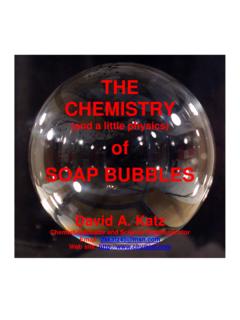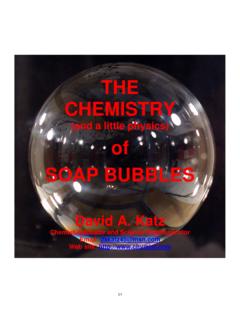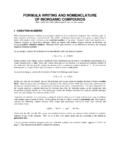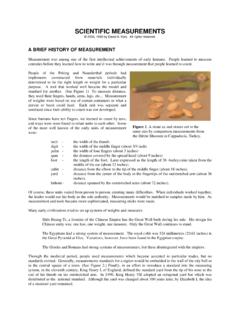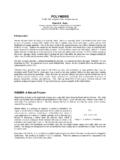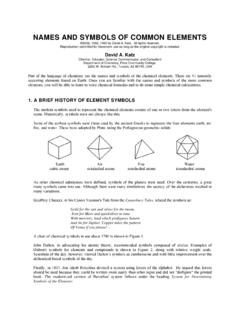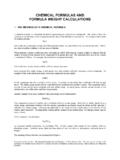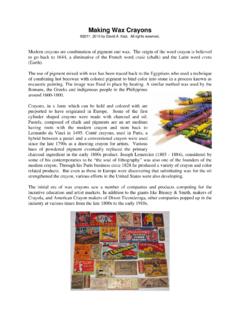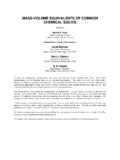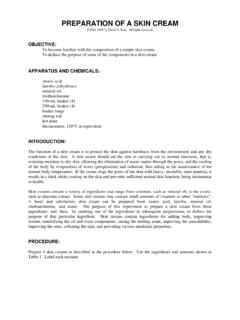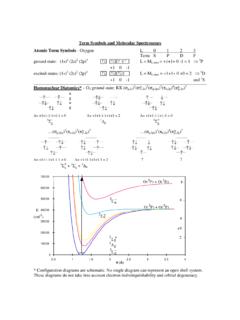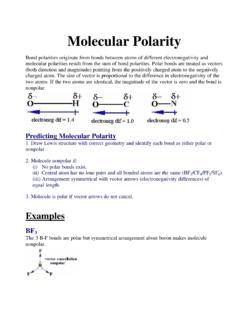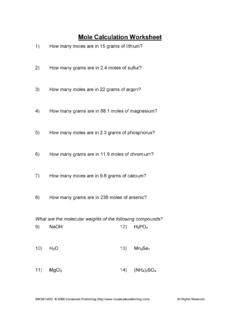Transcription of AN EXPERIMENT USING MOLECULAR MODELS
1 THE STRUCTURE OF MOLECULES. AN EXPERIMENT USING MOLECULAR MODELS . 2009 by David A. Katz. All rights reserved. In a footnot to a 1857 paper, Friedrich August Kekul suggested that carbon was tetratomic, that is, carbon has a valence of 4. In 1858, Kelkul stated When the simplest compounds of this element are considered (marsh gas, methyl chloride, chloride of carbon, chloroform, carbonic acid, phosgene, sulphide of carbon, hydrocyanic acid, etc.) it is seen that the quantity of carbon which chemists have recognized as the smallest possible, that is, as an atom, always unites with 4 atoms of a monoatomic or with 2 atoms of a diatomic element; that in general the sum of the chemical units of the elements united with one atom of carbon is 4. This leads us to the view that carbon is tetratomic or tetrabasic. In the cases of substances which contain several atoms of carbon, it must be assumed that at least some of that atoms are in the same way held in the compound by the affinity of carbon, and the carbon atoms attach themselves to one another.
2 As early as 1870, graphic formulas of carbon compounds were drawn as shown: H H H.. Methane H C H ethylene C=C.. H H H. These drawings imply that the atom-atom linkages, indicated by valence strokes, lie in plane. In 1874, Jacobus Henricus van 't Hoff and Joseph Achille LeBel, independently, proposed that the four bonds of carbon were arranged three dimensionally, pointed toward the corners of a tetrahedron. The tetrahedral carbon atom is sometimes referred to as the Van't Hoff-Le Bel theory. The three- dimensional structure of methane can be represented by a diagram known as a Fischer projection: The physical significance of the chemical linkages between atoms, expressed by the lines or valence strokes in MOLECULAR structure diagrams, became evident soon after the discovery of the electron. In 1916 in a classic paper, G. N. Lewis suggested, on the basis of chemical evidence, that the single bonds in graphic formulas involve two electrons and that an atom tends to hold eight electrons in its outermost or valence shell.
3 Lewis' proposal that atoms generally have eight electrons in their outer shells is known as the octet rule. It can be applied to many atoms, but is particularly important in the treatment of covalent compounds of atoms in the second and third rows of the Periodic Table. For atoms such as carbon, oxygen, nitrogen, and fluorine, the eight valence electrons occur in pairs that occupy tetrahedral positions around the central atom core. Some of the electron pairs do not participate directly in chemical bonding and are called unshared or nonbonding pairs; however, the structures of compounds containing such unshared pairs reflect the tetrahedral arrangement of the four pairs of valence shell electrons. In the H2O molecule, which obeys the octet rule, the four pairs of electrons around the central oxygen atom occupy essentially tetrahedral positions; there are two unshared nonbonding pairs and two bonding pairs that are shared by the O atom and the two H atoms.
4 The H O H bond angle is nearly but not exactly tetrahedral since the properties of shared and unshared pairs of electrons are not exactly alike. Essentially, all organic molecules obey the octet rule, and so do most inorganic molecules and ions. For species that obey the octet rule it is possible to draw electron-dot, or Lewis, structures. The drawing of the H 2 O molecule, above, is an example of a Lewis structure. In a Lewis structure there are eight electrons around each atom (except for H atoms, which always have two electrons) Group 2A atoms which form 2 bonds have 4. electrons and Group 3A atoms which form 3 bonds have 6 electrons. There are two electrons in each bond (designated by a line). When counting electrons in these structures, one considers the electrons in a bond between two atoms as belonging to the atom under consideration.
5 Thus, electrons may be counted twice, once for each atom in the bond. The bonding and nonbonding electrons in Lewis structures are all from the outermost shells of the atoms involved, and are the so-called valence electrons of those atoms. For the main group elements, the number of valence electrons in an atom is equal to the group number of the element in the Periodic Table. Hydrogen in Group 1 has one valence electron, carbon, in Group 4, has four valence electrons, and chlorine, in Group 7, has seven valence electrons. In an octet rule structure the valence electrons from all the atoms are arranged in such a way that each atom, except hydrogen and the Group 2 and Group 3 atoms, have eight electrons. Construction of an octet rule structure for a molecule can be accomplished by counting the number of electrons. USING water as an example, an oxygen atom has six valence electrons (Group 6) and a hydrogen atom has one, the structure would need one O and two H atoms have a total of eight valence electrons; the octet rule structure for H 2O can be observed in the structure shown earlier.
6 Structures like that of H2O, which involve only single bonds and nonbonding electron pairs, are common. Sometimes, however, there is a "shortage" of electrons; that is, it is not possible to construct an octet rule structure in which all the electron pairs are either in single bonds or are nonbonding pairs. Ethene or ethylene, C 2H4, is a typical example of such a species. In such cases, octet rule structures can often be made in which two atoms are bonded by two electron pairs, rather than one pair. The two pairs of electrons form a double bond. In the C2H4 molecule, shown below, the C atoms each get four of their electrons from the double bond. The assumption that electrons behave this way is supported by the fact that the C=C double bond is both shorter and stronger than the C C single bond in the C 2H6 molecule. Double bonds, and triple bonds, occur in many molecules, usually between C, O, N, and/or S atoms.
7 H H.. Ethene or ethylene C=C.. H H. Lewis structures can be used to predict MOLECULAR and ionic geometries by assuming that the four pairs of electrons around each atom are arranged tetrahedrally. This is the method used to determine the geometry for H 2 O. In the C 2 H 4 molecule, the shape around each carbon atom is triangular (or trigonal) planar. (The two bonding pairs in the double bond are not lined up between the two nuclei, but are spread out in space above and below the plane of the molecule). In describing MOLECULAR geometry we indicate the positions of the atomic nuclei, not the electrons. The idea of a correlation between MOLECULAR geometry and number of valence electrons (both shared and unshared) was first presented in 1940 by Sidgwick and Powell. In 1957, R. J. Gillespie and R. S. Nyholm refined this concept to build a more detailed theory capable of choosing between various alternative geometries.
8 This theory is known as the Valence Shell Electron Repulsion Theory (VSEPR). The VSEPR theory assumes 1. The electron pairs in the valence shell of a central atom repel each other. 2. The electron pairs occupy positions in space that minimize repulsions and maximize the distance of separation between them. ( , they are as far away from each other as possible). 3. The valence shell is treated as a sphere with electron pairs spread out on the spherical surface at maximum distance from one another. 4. A multiple bond is treated as if it is a single electron pair for determining the MOLECULAR geometry. There are some additional effects of the two or three electron pairs of a multiple bond on the actual bond angles. 5. Where two or more resonance structures can depict a molecule the VSEPR model is applicable to any such structure. Three types of repulsion take place between the electrons of a molecule: 1.
9 The lone pair-lone pair repulsion 2. The lone pair-bonding pair repulsion 3. The bonding pair-bonding pair repulsion. The VSEPR shapes for compounds formed from Group 2 to Group 6 atoms are given in Table 1. In addition to the common VSEPR shapes for the Group 5 and Group 6 elements, these elements may form structures that violate the octet rule by having 5 or 6 bonds to the central atom. Some examples of these molecules are given in Table 2. It is also possible to predict polarity from Lewis structures. Polar molecules have their center of positive charge at a different point than their center of negative charge. This separation of charges produces a dipole moment in the molecule. Covalent bonds between different kinds of atoms are polar; all heteronuclear diatomic molecules are polar. In some symmetrical molecules the polarity from one bond may be canceled by that from others.
10 Carbon dioxide, CO2, which is linear, is a nonpolar molecule. Methane, CH 4 , and carbon tetrachloride, CCl 4 which are tetrahedral, are also nonpolar. Non-symmetrial molecules such as CH 3 Cl will be polar. Molecules with nonbonded electron pairs on the central atom are usually polar. Although the conclusions we have drawn regarding MOLECULAR geometry and polarity can be determined from a combination of VSEPR shapes and Lewis structures , it is much easier to draw such conclusions by constructing MODELS of molecules and ions. MODELS tend to be easier to construct than the drawings of Lewis structures on paper. In addition, the MODELS are three-dimensional and are much more representative of the actual species. USING the MODELS , it is relatively easy to see both geometry and polarity, as well as to deduce Lewis structures. In this EXPERIMENT you will assemble MODELS for a number of common chemical species and interpret them in the ways we have discussed.
